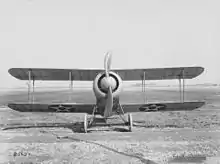Standard E-1
The Standard E-1 was an early American Army fighter aircraft, tested in 1917.[1] It was the only pursuit aircraft manufactured by the United States during World War I.[2] It arrived late in World War I, and as a result saw more use in the months following the Armistice than those preceding it.[3]
| Standard E-1 | |
|---|---|
 | |
| Standard E-1 of 1919 displayed in the Virginia Aviation Museum at Richmond, Virginia in
USAAS markings | |
| Role | Military trainer |
| National origin | United States of America |
| Manufacturer | Standard Aircraft Corporation |
| First flight | 1917 |
| Primary user | United States Army Air Service |
| Number built | 168 |
Design and development
Built by the Standard Aircraft Corporation, the E-1 was an open-cockpit single-place tractor biplane, powered by an 80 hp (60 kW) Le Rhône or 100 hp (75 kW) Gnome rotary engine.[4]
Operational history
It proved unsuitable as a fighter, but 128 were bought as an advanced trainer.[5] Of these, 30 were powered by the Gnome rotary engine of 100 horsepower and 98 were powered by the LeRhone C-9 rotary engine of 80 horsepower.[3] After World War I, three were modified as RPVs.
Operators
- United States Army Air Service
- United States Navy - 10 aircraft received from the Army (A-4218 to A-4227)[6]
Survivors
- A late 1918 E-1 was on display at the National Museum of the United States Air Force in Dayton, Ohio for over 40 years. It was placed on indefinite loan to the Museum by J. B. Petty of Gastonia, North Carolina in 1959.[3] After Mr. Petty passed on, the aircraft was sold at auction by his estate and eventually was obtained by Kermit Weeks and is now part of the collection at Fantasy of Flight in Polk City, Florida.[4]
- A 1918 E-1 is on display at the Shannon Air Museum in Fredericksburg, Virginia. This airframe was found at a florist shop in Dayton, Ohio in the 1950s and restored for display.[2][7]
Specifications



Data from The American Fighter[8]
General characteristics
- Crew: One pilot
- Length: 18 ft 11 in (5.76 m)
- Wingspan: 24 ft 0 in (7.31 m)
- Height: 7 ft 10 in (2.38 m)
- Wing area: 153 sq ft (14.21 m2)
- Empty weight: 380 lb (838 kg)
- Gross weight: 1,140 lb (519 kg)
- Powerplant: 1 × Le Rhône rotary , 80 hp (60 kW)
Performance
- Maximum speed: 100 mph (160 km/h, 87 kn)
- Endurance: 2 hours
- Service ceiling: 14,800 ft (4,510 m)
See also
Aircraft of comparable role, configuration, and era
Related lists
References
- Notes
- Taylor 1989, p. 839.
- "Historical Aircraft." Archived 2011-07-28 at the Wayback Machine Virginia Aviation Museum. Retrieved: 14 February 2011.
- United States Air Force Museum 1975, p. 11.
- "Standard E-1." Fantasy of Flight. Retrieved: 26 March 2012.
- Donald 1997, p. 854.
- Evans, Mark L. (2015). United States Naval Aviation 1910-2010, Vol. 2 (PDF). p. 103. Retrieved 18 June 2023.
- P. B. Sullivan 1976, P. 2-3.
- Angelicci and Bowers 1987, p. 416.
- Bibliography
- Angelucci, Enzo. The Rand McNally Encyclopedia of Military Aircraft, 1914-1980. San Diego, California: The Military Press, 1983. ISBN 0-517-41021-4.
- Angelucci, Enzo and Peter Bowers. The American Fighter. Sparkford, UK: Haynes Publishing Group, 1987. ISBN 0-85429-635-2.
- Donald, David, ed. "Standard Aircraft." Encyclopedia of World Aircraft. Etobicoke, Ontario: Prospero Books, 1997. ISBN 0-7607-0592-5.
- Taylor, Michael J. H. Jane's Encyclopedia of Aviation. London: Studio Editions, 1989. ISBN 0-517-69186-8.
- United States Air Force Museum Guidebook. Wright-Patterson AFB, Ohio: Air Force Museum Foundation, 1975.
External links
- This page contains material originally created for Standard E-1